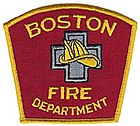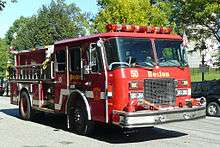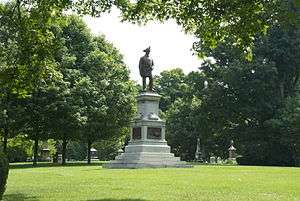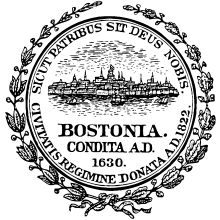Boston Fire Department
The Boston Fire Department provides fire protection and first responder emergency medical services to the city of Boston, Massachusetts. In addition to fire protection, the department responds to a variety of emergencies such as medical emergencies, motor vehicle accidents, hazardous material spills, electrical hazards, floods, and construction accidents.
 | |
| "First in the Nation" | |
| Operational area | |
|---|---|
| Country | |
| State | |
| City | |
| Agency overview[1] | |
| Established | 1678 |
| Annual calls | 74,191 (2013) |
| Employees | 1,611 (2014)
|
| Annual budget | $187,849,951 (2014) |
| Staffing | Career |
| EMS level | First responder |
| IAFF | 718 |
| Facilities and equipment[1][2] | |
| Divisions | 2 |
| Battalions | 9 |
| Stations | 34 |
| Engines | 33 |
| Trucks | 20 |
| Platforms | 2 |
| Rescues | 2 |
| HAZMAT | 1 |
| USAR | 1 |
| Wildland | 2 |
| Fireboats | 2 |
| Rescue boats | 2 |
| Light and air | 1 |
| Website | |
| Official website | |
| IAFF website | |
The Boston Fire Department was established as the first paid fire department in the United States, and is the largest municipal fire department in New England serving approximately 685,000 people living in a 47-square-mile (120 km2) area of the city proper and provides additional mutual aid to 32 surrounding communities of the Greater Boston Metro Area, including Logan International Airport.
In and around Boston, firefighters are sometimes referred to as Jakes.[3]
History
1631−1678
The Boston Fire Department traces its roots back to 1631, a year after the city was founded, when the first fire ordinance was adopted. In what then was the Massachusetts Bay Colony of the Kingdom of England, the city banned thatched roofs and wooden chimneys. However, it wasn't until 1653 that the first hand engine was appropriated to provide pressure for water lines.[4][5]
1678−1837
In 1678, the city founded a paid fire department, and hired Thomas Atkins to be the first fire chief.[4] On February 1, 1711, the town appointed a group of Fire Wards, each responsible for the operation and maintenance of equipment assigned to a region of the city.[6] The grandfather and great grandfather of Herman Melville, Thomas Melvill, served as a town fire ward from 1779 to 1825, and Allen Melvill, served as an early firefighter 1733 to 1761.[7][8] It was not until 1799 that the first leather fire hose was used, after being imported from England.[4]
1837−1910
The department underwent its first reorganization in 1837 when the hand engine department reorganized, reducing the number of active engines to fourteen.[6] By December 31, 1858, the department had 14 hand engines, 3 hook and ladder carriages, and 6 hydrant (hose) carriages.[6] On November 1, 1859, Engine Co. 8 began service as the first steam engine in the department. The reorganization of 1859-60 replaced the department's 14 hand engines with 11 new steam engines, forming the departmental hierarchy still used today.[6]
The department was the first in the world to utilize the telegraph to alert fire fighters of an emergency, installing the system in 1851.[4] The first fire alarm was transmitted via the Fire Alarm Telegraph system on April 29, 1852.[6] The famous Boston fire of 1872 led to the appointment of a board of fire commissioners. The Boston Fire Department also provided assistance in the Great Chelsea Fire of 1908 and the Great Salem Fire of 1914.[6] The department purchased its first steam fireboat in 1873, and installed fire poles in the stations in 1881.[4]
1910−present
On July 29, 1910, the department purchased its first motorized apparatus. From 1914 until 1923, horse drawn engines as well as steam and motorized engine companies were in use in Boston. Ladder 24 was the last company to replace its horses in 1923 when it became motorized.[6] In 1925, the last fire horses were retired.[4] It wasn't until 1926 that the last steam engine was converted to a motorized engine.[6] The department first started using radio communication in 1925, installing radios in the fireboats, chiefs' cars, and rescue companies.[4]
By 1960, the department operated 48 engines, 29 ladders, 1 rescue, and 2 fireboats.[6] By the end of the decade, the standard 85-foot (26 m) ladder trucks were replaced by 100-foot (30 m) aerial ladders with tillers.[6]
In the 1970s, the department experimented with lime-green colored apparatus, but reverted to the traditional red in 1984, when the Department made the switch to E-One fire apparatus.[6] In the early 1980s, an arson ring caused over 600 fires, many reaching multiple-alarm status. The group was ultimately caught and convicted.[6]
Also in the early 1980s, the Department experienced a dramatic number of cutbacks due to budget cuts. The number of Engine Companies dropped from 43 to 33, the Fire Brigade was disbanded (only to be reopened in the mid-80's), the number of Ladder Companies went from 28 to 21, and one of the two Tower Companies was disbanded and reduced to a regular Ladder Company (bringing the total to 22 Ladder Companies). Rescue 2 was disbanded, but reorganized in 1986.
2007 Boston bomb scare
On January 31, 2007, the department, Boston Police, and the United States Department of Homeland Security had to act agile to dispose LED advertisements resembling the mooninite characters of the Cartoon Network show Aqua Teen Hungerforce for its movie which had premiered at the time, Aqua teen hunger force colon movie film for theaters as perpetrated by two males named "Sean Stevens" and "Steven Bardovsky". Both of them were hired by Turner Broadcasting, Interference, Inc., and Cartoon Network to display the aforementioned advertisements throughout the entire city and were mistaken for homemade explosives. A civil settlement was eventually reached with Turner, Interference, and Cartoon Network for some portion of the costs incurred by Boston Police and Department of Homeland Security in responding to the events. One of Cartoon Network's managerial staff also resigned in the aftermath.
On June 3, 2013, Chief Steve Abraira resigned citing public criticism from his deputies over his response to the Boston Marathon bombing.[9]
Organization
The Boston Fire Department has six divisions:[10]
- Fire Suppression and rescue services
- The most visible division of the department, this division provides the fire protection and rescue services for the city of Boston with uniformed firefighters being dispatched to and responding to a variety of emergencies.[11] The services provided include firefighting, first responder emergency medical services, hazardous materials response, vehicle extrication and other services. The department operates engine companies, ladder companies, and rescue companies, each providing distinctly separate services at a fire or other emergency.
- Fire Prevention
- This division is responsible for maintaining records, granting permits, conducting public education, and inspecting buildings.[12]
- Training
- This division supervises the development of the fire fighters from probation to retirement. Also, the division conducts research to improve techniques and equipment, evaluating new tools before their implementation. The Emergency Medical Services and the Safety Operations Unit are also within this division.[13]
- Personnel
- This division includes the Administration Section, Selection Unit, Medical Office, Personnel Assignments of Officer’s Section, and the Employees Assistant Program. The division keeps the records of each fire fighter, communicates with other departments, unions, and agencies, and hears grievances, disciplinary hearings, and appeals.[14]
- Emergency Planning and Preparedness
- This division was established in 1996 to replace the Special Services Division, providing the city with an Incident Command System, Office of Emergency Management, and Local Emergency Planning Committee.[15]
- Special Operations Command
- This division was established in 2001 with a goal of recommending training, deployment and equipment for the Boston Fire Department in all areas of rescue services including technical rescue, CBRNE/hazardous materials operations as well as Dive Team and Marine Unit operations.[16]
Fire Commissioners
- Henry S. Russell: 1895–1905
- Patrick J. Kennedy (acting): 1905
- Benjamin W. Wells: 1905–1908
- Samuel D. Parker: 1908–1910
- Francis M. Carroll (acting): 1910
- Charles Dudley Daly: 1910–1912
- John H. Dunn (acting): 1912
- Charles H. Cole: 1912–1914
- John M. Minton (acting): 1914
- John Grady: 1914–1919
- John R. Murphy: 1919–1921
- Joseph P. Manning (acting): 1921–1922
- William J. Casey (acting): 1922
- Theodore A. Glynn: 1922–1926
- Thomas F. Sullivan (acting): 1926
- Eugene Hultman: 1926–1930
- Edward F. McLaughlin: 1930–1933
- Eugene M. McSweeney: 1933–1934
- Edward F. McLaughlin: 1934–1938
- William Arthur Reilly: 1938–1945
- John I. Fitzgerald: 1945–1946
- Russell S. Codman Jr.: 1946–1950
- Michael T. Kelleher: 1950–1953
- John F. Cotter: 1953–1954
- Francis X. Cotter: 1954–1959
- Timothy J. O'Connor: 1959–1960
- Henry Scagnoli: 1960–1961
- Thomas Griffin: 1961–1966
- Henry A. Scagnoli (acting): 1966
- William J. Fitzgerald: 1966–1968
- James H. Kelly: 1968–1975
- George Paul: 1975–1984
- Leo Stapleton: 1984–1991
- Martin E. Pierce Jr.: 1991–2000
- Dennis DiMarzio (acting): 2000–2001
- Paul Christian: 2001–2006
- Kevin P. MacCurtain (acting): 2006
- Roderick Fraser: 2006–2014
- John Hasson (acting): 2014
- Joseph E. Finn: 2014–2020
- John Dempsey: 2020-present
Firehouses and apparatus

.jpg)


The Boston Fire Department operates 2 Divisions and is split into 9 Districts total.[2] Division 1 is responsible for the northern part of Boston and is split into five districts (Districts 1, 3, 4, 6 and 11) while Division 2 commands the southern four districts (Districts 7, 8, 9 and 12).[2] Each Division is commanded by a Deputy Chief and each District is commanded by a District Chief, similar to a Battalion chief, who supervises 3-5 or more firehouses and their respective fire companies. There is also a Safety Chief, a district chief, who serves citywide as the Incident Safety Officer at fires and large-scale incidents.
The Marine Unit of the BFD is located at Burrough's Wharf in the North End and houses the 3 Fireboats or Marine Units. The Marine Unit responds to approximately 500−600 emergency calls annually.[17] The Boston Fire Department also operates a High-Pressure Pumping Station at 175 Kneeland St. in Downtown and contains 17 miles of underground piping throughout the Downtown area. The system can provide pressurized water to the many pressurized fire hydrants in the Downtown area.[18]
In addition to the firehouses, the BFD also operates a Special Operations Command/Haz-Mat. Facility at 108 Holton St. in Brighton, a Communications/Fire Alarm Dispatch Center at 1 Fenway in Roxbury, and an Administrative Headquarters/Motor Pool Facility at 115 Southampton St. in Roxbury. The Fire Academy is located on Moon Island.[19]
| Engine Company | Ladder Company Or Tower Ladder Company | Special Unit | Car or Chief Unit (District Chief, Division Chief or Safety Chief) | Address | Neighborhood | District | Division |
|---|---|---|---|---|---|---|---|
| Engine 2 | Ladder 19 | 700 E. Fourth St. | Telegraph Hill/South Boston | 6 | 1 | ||
| Engine 3 | Special / Lighting Unit | 618 Harrison Ave. | South End | 4 | 1 | ||
| Engine 4 | Ladder 24 | Car 3 (District 3 Chief) | 200 Cambridge St. | West End | 3 | 1 | |
| Engine 5 | Car 1 (District 1 Chief) | 360 Saratoga St. | East Boston | 1 | 1 | ||
| Engine 7 | Ladder 17 | Car 4 (District 4 Chief) | 200 Columbus Ave. | Back Bay | 4 | 1 | |
| Engine 8 | Ladder 1 | 392 Hanover St. | North End | 3 | 1 | ||
| Engine 9 | Ladder 2 | 239 Sumner St. | Maverick Square/ East Boston | 1 | 1 | ||
| Engine 10 | Tower Ladder 3 | Rescue 1, Technical Support Unit 1, Collapse Unit | Chief 6 (Division 1 Chief) | 125 Purchase St. | Downtown | 6 | 1 |
| Engine 14 | Ladder 4 | H-1 (Safety Chief) | 174 Dudley St. | Nubian Square/Roxbury | 7 | 2 | |
| Engine 16 | 9 Gallivan Blvd. | Dorchester | 8 | 2 | |||
| Engine 17 | Ladder 7 | Car 7 (District 7 Chief) | 7 Parish St. | Meeting House Hill/Dorchester | 7 | 2 | |
| Engine 18 | Ladder 6 | 1884 Dorchester Ave. | Ashmont/Dorchester | 8 | 2 | ||
| Engine 20 | Dive Unit | 301 Neponset Ave. | Neponset/Dorchester | 8 | 2 | ||
| Engine 21 | 641 Columbia Rd. | Upham's Corner/Dorchester | 7 | 2 | |||
| Engine 22 | Haz-Mat. Unit, Rehab. Unit | 700 Tremont St. | South End | 4 | 1 | ||
| Engine 24 | Ladder 23 | 36 Washington St. | Grove Hall/ Roxbury | 7 | 2 | ||
| Engine 28 | Tower Ladder 10 | Technical Support Unit 2 | Chief 7 (Division 2 Chief) | 746 Centre St. | Jamaica Plain | 9 | 2 |
| Engine 29 | Ladder 11 | Car 11 (District 11 Chief) | 138 Chestnut Hill Ave. | Brighton | 11 | 1 | |
| Engine 30 | Ladder 25 | 1940 Centre St. | West Roxbury | 12 | 2 | ||
| Engine 32 | Ladder 9 | 525 Main St. | Charlestown | 3 | 1 | ||
| Engine 33 | Ladder 15 | 941 Boylston St. | Back Bay | 4 | 1 | ||
| Engine 37 | Ladder 26 | 560 Huntington Ave. | Fenway/Roxbury | 9 | 2 | ||
| Engine 39 | Ladder 18 | Decon. Unit 1 | Car 6 (District 6 Chief) | 272 D St. | South Boston | 6 | 1 |
| Engine 41 | Ladder 14 | 460 Cambridge St. | Allston | 11 | 1 | ||
| Engine 42 | Rescue 2 | Car 9 (District 9 Chief) | 1870 Columbus Ave. | Egleston Square/ Roxbury | 9 | 2 | |
| Engine 48 | Ladder 28 | Brush Unit 48 | 60 Fairmount Ave. | Cleary Square/ Hyde Park | 12 | 2 | |
| Engine 49 | 209 Neponset Valley Pkwy. | Readville/ Hyde Park | 12 | 2 | |||
| Engine 50 | 54 Winthrop St. | Bunker Hill/ Charlestown | 3 | 1 | |||
| Engine 51 | 425 Faneuil St. | Brighton | 11 | 1 | |||
| Engine 52 | Ladder 29 | 975 Blue Hill Ave. | Dorchester | 8 | 2 | ||
| Engine 53 | Ladder 16 | Car 12 (District 12 Chief) | 945 Canterbury St. | Roslindale | 12 | 2 | |
| Engine 55 | Brush Unit 55 | 5115 Washington St. | West Roxbury | 12 | 2 | ||
| Engine 56 | Ladder 21 | 1 Ashley St. | Orient Heights/ East Boston | 1 | 1 | ||
| Marine Unit 1, Marine Unit 2, Marine Unit 3 | Burrough's Wharf | North End | 3 | 1 |
Radio call signs
Each division within the Boston Fire Department utilizes a series of alphabetical radio call signs to designate each unit within a certain division.[20]
| Call Sign | Division |
|---|---|
| A | Associated Organizations |
| B | M.O.E.P. |
| C | Administrative Officers/Headquarters Staff |
| G | Emergency Planning and Preparedness Division |
| H | Special Operations Units |
| I | Information Technology Division |
| J | SCUBA Team |
| K | Fire Prevention/Investigation Division |
| M | Maintenance Section/Motor Pool |
| N | Field Services Unit |
| P | Boston Police Department Unit's |
| S | Fire Alarm |
| T | Special Operations Command |
| W | Training |
| X | Emergency Medical Response Division |
Notable Fires
Great Fire of 1760
The first "Great Fire" of Boston destroyed 349 buildings on March 20, 1760.
Great Fire of 1872
The second "Great Fire" of Boston began on November 9, 1872. The fire destroyed 776 buildings, killed 13 people, and caused $75,000,000 in property damage.[4] The fire required mutual aid companies from as far away as New Haven, Connecticut and Manchester, New Hampshire.
Cocoanut Grove Fire
The Cocoanut Grove fire was the second-deadliest single-building fire in American history. At 10:15 PM on November 28, 1942 the fire began when a short in the electrical wiring ignited gas leaking from a faulty refrigeration unit.[21] The fire eventually claimed 490 lives, and injured 166 more.[21] Only the 1903 Iroquois Theatre fire in Chicago had a higher death toll at 605.
Vendome Hotel Fire
At 2:35 PM on Saturday, June 17, 1972, an alarm from Box 1571 was received for the Hotel Vendome on Commonwealth Avenue in the Back Bay.[22] It took nearly three hours to get the 4-alarm blaze under control. At 5:28 PM, during overhaul operations, the southeast section of the building unexpectedly collapsed.[22] The collapse killed 9 Boston firefighters: Lieutenant Thomas J. Carroll (Engine 32), Lieutenant John E. Hanbury (Ladder 13), Firefighter Richard B. Magee (Engine 33), Firefighter Joseph F. Boucher (Engine 22), Firefighter Paul J. Murphy (Engine 32), Firefighter John E. Jameson (Engine 22), Firefighter Charles E. Dolan (Ladder 13), Firefighter Joseph P. Saniuk (Ladder 13) and Firefighter Thomas W. Beckwith (Engine 32); and injuring 8 more.[6] This fire was the worst tragedy in the history of the Boston Fire Department and one of the most deadly fires in the history of U.S. firefighting.
Beacon Street Fire
On the afternoon of March 26, 2014, firefighters responded to a report of a fire in a Beacon Street Brownstone in Boston's Back Bay.[23] It was reported that smoke was observed upon arrival. Shortly after crews entered the building, a mayday alarm was sounded as members of Engine 33 became trapped in the basement. Two firefighters, Lieutenant Edward Walsh of Engine Company 33 and Michael Kennedy of Ladder Company 15, were killed and 18 people were injured in this nine alarm fire.[24]
See also
References
- "Boston Fire Department Overview". Retrieved 2007-04-22.
- "Firehouse Locations". Boston Fire Department. Retrieved 2 April 2015.
- "Why Are Boston Area Firefighters Called 'Jakes'?". News. 2019-04-24. Retrieved 2020-06-19.
- "Boston Fire Department History". Retrieved 2007-04-22.
- Brayley, Arthur Wellington (1889). A Complete History Of The Boston Fire Department ... From 1630 To 1888. Boston: John P. Dale & Co. Retrieved 2009-07-14.
- "Boston Fire Museum, History of BFD". Archived from the original on 2007-08-22. Retrieved 22 April 2007.
- Francis Samuel Drake. Tea leaves: being a collection of letters and documents. Boston: A.O. Crane, 1884.
- Brayley, Arthur Wellington (1889). A Complete History of the Boston Fire Department. J. P. Dale.
- "Embattled Boston Fire Chief Steve Abraira resigns". boston.com. Retrieved 3 June 2013.
- "Boston Fire Department Divisions". Retrieved 2007-04-22.
- "Fire Suppression". Boston Fire Department.
- "Fire Prevention". Boston Fire Department.
- "Training". Boston Fire Department. Retrieved 2 April 2015.
- "Personnel". Boston Fire Department. Retrieved 2 April 2015.
- "Emergency Planning". Boston Fire Department. Retrieved 2 April 2015.
- "Special Operations". Boston Fire Department. Retrieved 2 April 2015.
- "Boston Fire Historical Society". Bostonfirehistory.org. Archived from the original on 2013-11-12. Retrieved 2014-04-08.
- "Boston Fire Historical Society". Bostonfirehistory.org. 1921-12-19. Archived from the original on 2013-11-12. Retrieved 2014-04-08.
- http://firenews.org/mass/b/boston/stations/bostonstations.html
- "BFD Radio System". Angelfire.com. 2011-03-01. Retrieved 2014-04-08.
- Reilly, William Arthur (1943-11-19), Report concerning the Cocoanut Grove fire, November 28, 1942, Boston Fire Department, retrieved 2010-12-02
- Mochen, Kevin (15 November 2012). "10-15: Tragedy On Com Ave: The Collapse Of The Hotel Vendome". Fire Engineering Magazine. 2012 (11). Retrieved 27 March 2015.
- "2 firefighters killed in Boston blaze". CNN.com. Retrieved 2014-04-08.
- McPhee, Michele (June 2014). "Into the Fire". Boston Magazine. Retrieved 27 March 2015.
External links
| Wikimedia Commons has media related to Fire stations in Boston. |

